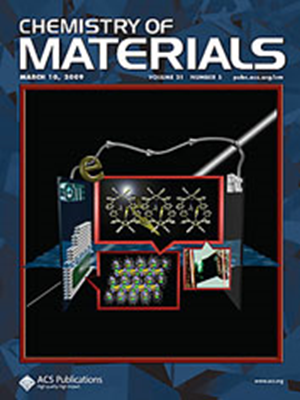La掺杂ATaO3 (A = Li, Na, K)提高光催化污染物降解性能
IF 7
2区 材料科学
Q2 CHEMISTRY, PHYSICAL
引用次数: 0
摘要
ATaO3 (A = Li, Na, K)光催化剂是效率最高的光催化剂之一,通过La掺杂可以进一步提高效率。在本研究中,探讨了La掺杂对ATaO3钙钛矿的影响。采用固体高温合成方法,在不同La摩尔%(0-10%)掺杂条件下合成了ATaO3 (A = Li, Na, K)纳米粒子。通过扫描透射电子显微镜证实,在NaTaO3和KTaO3体中实现了均匀的La掺杂,并且在纳米颗粒表面有一个额外的单原子层(有时是双原子层)。LiTaO3的掺杂不均匀,有待进一步发展。形成和表面能计算以及相应的Wulff形状与这些实验观察结果相关联,证实了La掺杂剂在这些纳米颗粒观察到的形状中的作用。流动条件下的模拟污染物光催化反应证实,La掺杂后,所有ATaO3的光催化活性都有所提高,其中对NaTaO3的改善最大。本研究结果强调了La掺杂在ATaO3 (A = Li, Na, K)钙钛矿中对提高各种应用的光催化性能的影响,包括能源和污染物降解。本文章由计算机程序翻译,如有差异,请以英文原文为准。

La Doping ATaO3 (A = Li, Na, K) to Improve Performance for Photocatalytic Pollutant Degradation
ATaO3 (A = Li, Na, K) photocatalysts are among the most efficient photocatalysts, and efficiency can be further improved by La doping. In this study, the effect of La doping on ATaO3 perovskites was explored for several A site elements. ATaO3 (A = Li, Na, K) nanoparticles were synthesized via a solid-state high temperature synthesis with varying La mol % doping (0–10%). Homogeneous La doping within NaTaO3 and KTaO3 bulk was achieved, with an additional single (at times double) atomic layer at the surface of the nanoparticles, as confirmed by scanning transmission electron microscopy. Doping in LiTaO3 was inhomogeneous and requires further development. Formation and surface energy calculations and corresponding Wulff shapes were correlated to these experimental observations, confirming the role of La dopants in the observed shape of these nanoparticles. Model pollutant photocatalytic reactions under flow conditions confirmed an increase in photocatalytic activity with La doping for all ATaO3, with the largest improvement observed for NaTaO3. The findings of this study highlight the effect of La doping in ATaO3 (A = Li, Na, K) perovskites to improve photocatalytic performance for various applications, including energy and pollutant degradation.
求助全文
通过发布文献求助,成功后即可免费获取论文全文。
去求助
来源期刊

Chemistry of Materials
工程技术-材料科学:综合
CiteScore
14.10
自引率
5.80%
发文量
929
审稿时长
1.5 months
期刊介绍:
The journal Chemistry of Materials focuses on publishing original research at the intersection of materials science and chemistry. The studies published in the journal involve chemistry as a prominent component and explore topics such as the design, synthesis, characterization, processing, understanding, and application of functional or potentially functional materials. The journal covers various areas of interest, including inorganic and organic solid-state chemistry, nanomaterials, biomaterials, thin films and polymers, and composite/hybrid materials. The journal particularly seeks papers that highlight the creation or development of innovative materials with novel optical, electrical, magnetic, catalytic, or mechanical properties. It is essential that manuscripts on these topics have a primary focus on the chemistry of materials and represent a significant advancement compared to prior research. Before external reviews are sought, submitted manuscripts undergo a review process by a minimum of two editors to ensure their appropriateness for the journal and the presence of sufficient evidence of a significant advance that will be of broad interest to the materials chemistry community.
 求助内容:
求助内容: 应助结果提醒方式:
应助结果提醒方式:


